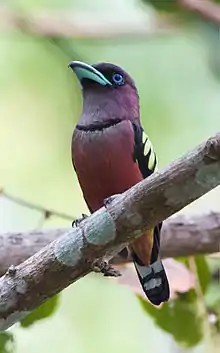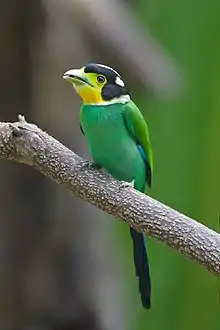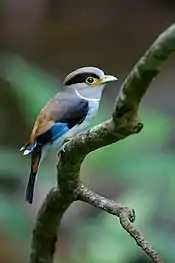Eurylaimidae
The Eurylaimidae are a family of suboscine passerine birds that occur from the eastern Himalayas to Indonesia and the Philippines. The family previously included the sapayoa from the Neotropics, the asities from Madagascar, and the Calyptomenidae from Africa, but these are now separated into distinct families.
| Eurylaimidae | |
|---|---|
 | |
| Banded broadbill Eurylaimus javanicus | |
| Scientific classification | |
| Kingdom: | Animalia |
| Phylum: | Chordata |
| Class: | Aves |
| Order: | Passeriformes |
| Superfamily: | Eurylaimoidea |
| Family: | Eurylaimidae |
| Genera | |
|
Cymbirhynchus | |
Description
Many of the species are brightly coloured birds that present broad heads, large eyes and a hooked, flat and broad beak. They range from 13 to 28 centimetres in length, and live in the dense canopies of wet forests, allowing them to hide despite their brightly coloured plumage.[1] The plumage of the juveniles eurylaimids are similar to those of the adults, differing in being duller and shorter-winged and shorter-tailed in some cases.[2]
Behaviour and ecology
They are for the most part insectivorous and carnivorous. Prey taken include insects, spiders, centipedes, and millipedes, as well as lizards and tree frogs. Prey is obtained by sallying from a perch to snatch it in flight, and gleaning the prey off leaves and branches while flying. Some species may take some fruit, but only the green broadbills of the genus Calyptomena and the Grauer's broadbill are primarily frugivores (which also take some insects as well).
They are generally gregarious, with many species moving about in flocks of about 20 individuals. They attach their purse-shaped nests to suspended vines, and leave a tail of fibres hanging below it. This gives the nest the appearance of being random debris caught in the tree, an effect further enhanced by the birds covering the nest with lichen and spider webs.[1] Broadbills typically lay two to three eggs.
Taxonomy and systematics
The family includes nine species of which five are each placed in their own monotypic genera:[3]
| Image | Genus | Living Species |
|---|---|---|
.jpg.webp) | Cymbirhynchus Vigors, 1830 |
|
 | Psarisomus Swainson, 1837 |
|
 | Serilophus Swainson, 1837 |
|
 | Eurylaimus Horsfield, 1821 |
|
 | Sarcophanops Gould, 1877 |
|
 | Corydon Lesson, 1828 |
|
| Pseudocalyptomena Rothschild, 1909 |
| |
References
- McClure, H. Elliott (1991). Forshaw, Joseph (ed.). Encyclopaedia of Animals: Birds. London: Merehurst Press. pp. 158–158. ISBN 1-85391-186-0.
- del Hoyo, J.; Elliott, A.; Christie, D. (2003). Handbook of the Birds of the World. Volume 8: Broadbills to Tapaculos. Lynx Edicions. ISBN 84-87334-50-4.
- Gill, Frank; Donsker, David, eds. (2019). "NZ wrens, Sapayoa, broadbills, asities, pittas". World Bird List Version 9.2. International Ornithologists' Union. Retrieved 26 June 2019.
Further reading
- Moyle, R.G.; Chesser, R.T.; Prum, R.O.; Schikler, P.; Cracraft, J. (2006). Phylogeny and evolutionary history of Old World suboscine birds (Aves: Eurylaimides). American Museum Novitates, Number 3544. New York: American Museum of Natural History.
External links
| Wikimedia Commons has media related to Eurylaimidae. |
- Broadbill videos on the Internet Bird Collection